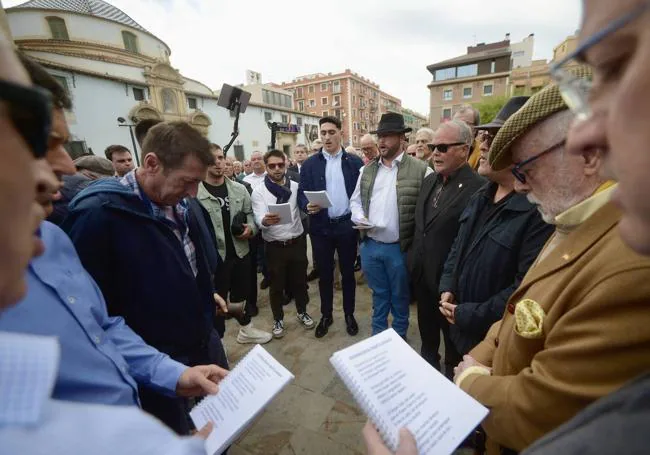Many are cautious for the most beautiful 'morá' morning. Because what will happen today, if the weather permits (there is no rain forecast), has been announced since Our Father Jesus, the head of the brotherhood that fills Murcia's Holy Week with history and art, was transferred to the Agustinas convent , their waitresses. And then he proclaimed himself again on his return last Holy Wednesday. Or in the call for mayordomos and mocking thirds that filled the city with music.
For those less warned, yesterday the last and definitive warning occurred, on that occasion by the auroros who sing the remote correlatives in the Plaza de San Agustín while the brothers of La Oración mounted the mythical palm tree, the steps were exposed in the church and the so-called cabildillos were held: the meetings of the mayordomos to organize the most famous penitence station in the city. Only one notice remains, this morning, as historic as it is indispensable: the banner of Jesus under the lintel of his temple announcing that the 'Morao' procession is taking to the streets.
The first step, the Holy Supper, was carried out by Salzillo in 1761. Each image shows an expression that shows its character. Thus, the admiration of Saint Andrew looking at Christ, the emotion of Saint Jude Thaddeus, the reflection of Saint Philip or the astonishment of Saint Simon add to the contempt of Judas Iscariot. Salzillo did not cut a shirt for him (a sign of cleanliness) and the border on his neck is silver, not gold like the rest. Splendid table adorned with silverware, fine tablecloth and excellent delicacies.
The Prayer in the Garden (1754) parades in second place. A widespread legend claims that the angel that comforts Jesus was sculpted by divine inspiration. Next he parades The Arrest or The Kiss (1763), in which the raised hand of Saint Peter stands out, the most perfect anatomical study.
Transfer last Wednesday of Nuestro Padre Jesús Nazareno from the Augustinian convent.
Nacho García / AGM
The last work carried out for the brotherhood, the Los Azotes pass (1778), appears in fourth place, followed by the Santa Mujer Verónica (1755). Next, in front of the headline, is the passage of The Fall (1752). The group is made up of Jesus, Simon of Cyrene, two executioners and a Roman. The throne contains one of Salzillo's anachronisms: the soldier wears armor from the late 16th century.
Our Father Jesús Nazareno is the only carving in the procession that did not leave Salzillo's workshop. It is attributed to Juan de Aguilera (1601). Later, Saint John (1756) seems to walk alone. The Dolorosa (1755) will close the procession, with the angels at her feet.
Art at night
The city will barely have recovered from the passage of Jesus, when three brotherhoods will complete Good Friday with processions of similar tradition and that awaken identical fervor among the Murcians. Mercy, Servites and Sepulcher will conclude one of the greatest Nazarene days.
The first procession will leave from San Bartolomé. In it you can admire the Servite Angel attributed to Vicente Hernández Couquet (1858). Behind, María Santísima de las Angustias, carving by Francisco Salzillo (1739), an icon of his production among black tunics and blue details.

Songs of the dawn, yesterday in the Plaza de San Agustín.
Nacho García / AGM
The second brotherhood also leaves from San Bartolomé, where the procession, in black, of the Brotherhood of the Holy Sepulcher of Our Lord Jesus Christ will form, known as the procession of the Holy Burial. This is the old official parade of the city, with representation from the Chapter of Brotherhoods, the Murcia City Council, guilds and other official institutions.
Among its steps is the Christ of Santa Clara la Real, by Francisco Salzillo (1770), the Virgin of Bitterness, by González Moreno (1946), the Holy Sepulcher (1941) and San Juan Evangelista (1952), both by the same author, and the Holy Virgin of Soledad, an anonymous person from the 17th century.
And from the church of San Esteban the last brotherhood of Good Friday will start. His images are Jesús Nazareno, by Roque López (1797), the Holy Christ of Mercy, by Domingo Beltrán (16th century), the Sacred Descent, by José Hernández Navarro (2001), and Our Lady Mother of Mercy, by Sánchez Lozano (1922). The robes of this institution are black and the hood magenta, which once earned it the nickname of the turkey procession.
This is how it will end this Friday late at night. There will only be two more processions left until we reach the Easter vigils that will be organized by all the parishes of the city with the participation of thousands of Christians. Preparations for both events will begin first thing tomorrow morning, the eve of the departure of the colorful procession of the Risen Lord.
#morning #39morá39 #afternoon #fervor #Murcia
